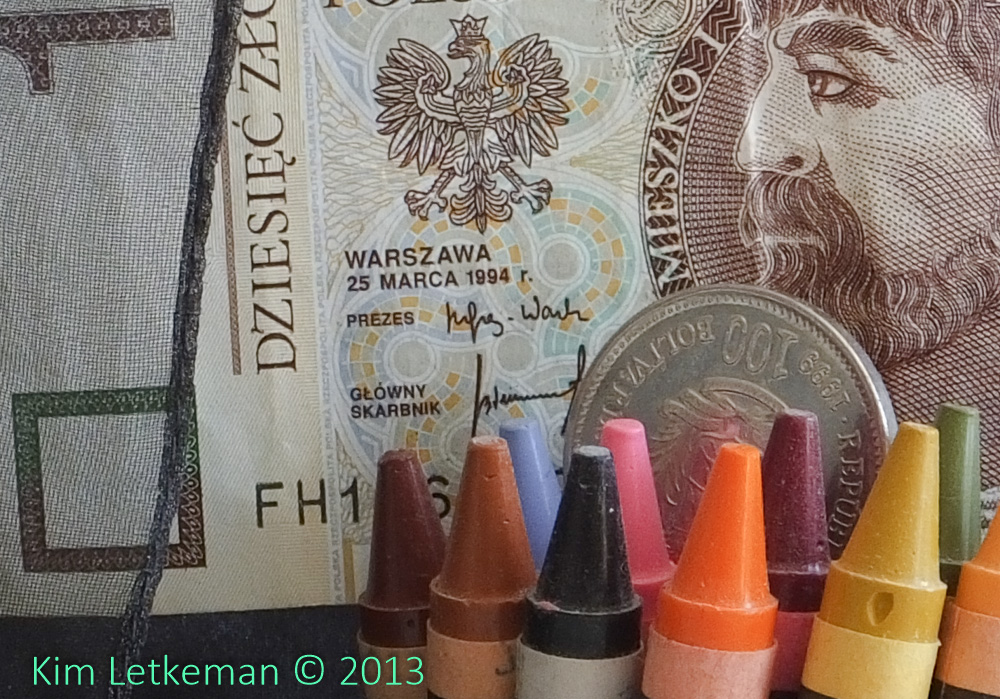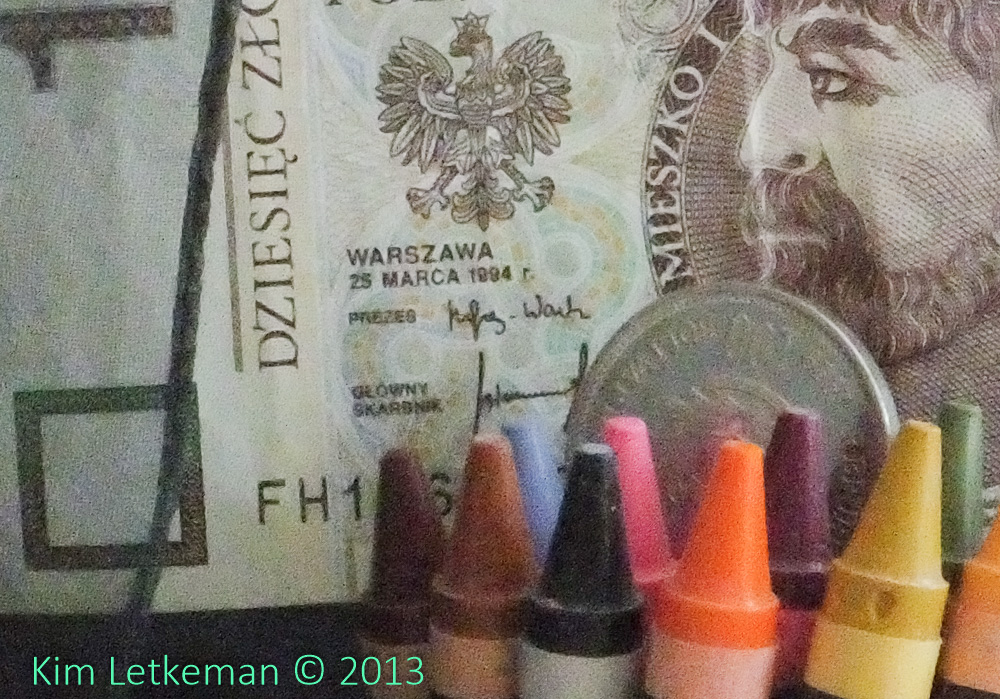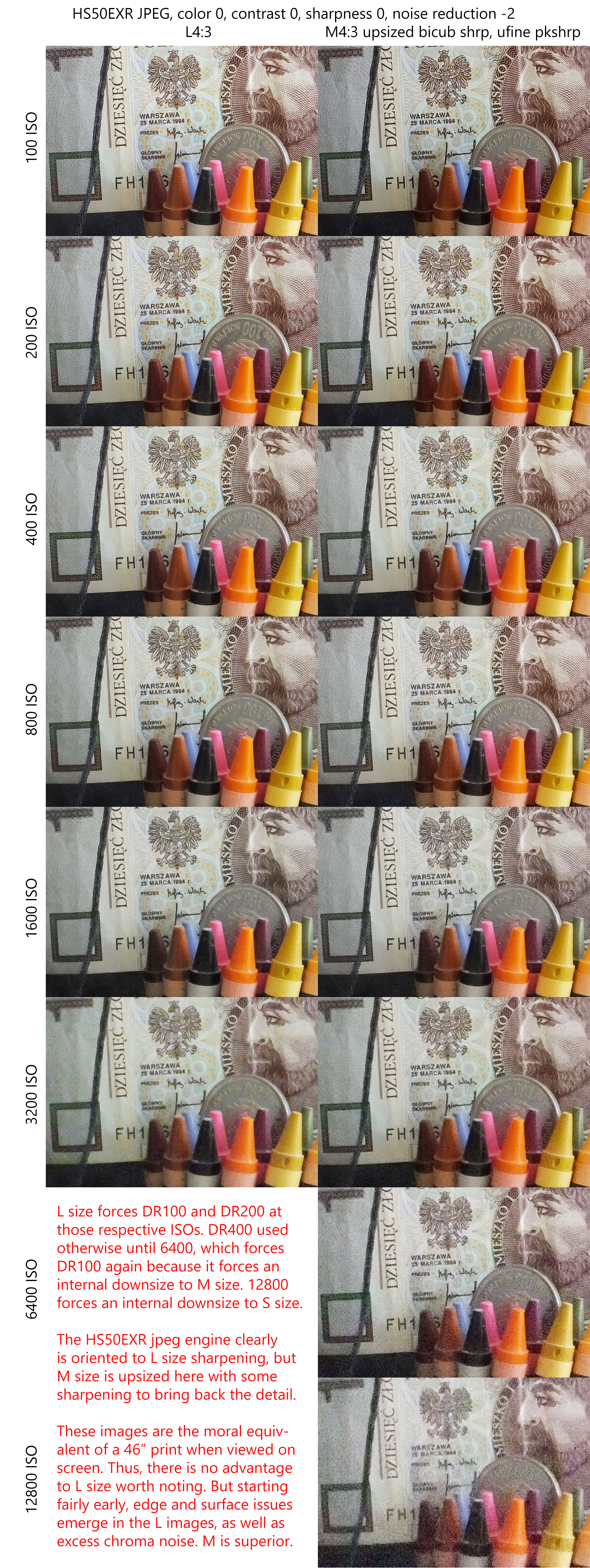So this time we have sunlight streaming in from a south facing window and a slightly changed subject and the best JPEG settings I know of right now. Which are:
DR400 (DR100 for L @100ISO, DR200 for L @200ISO, DR100 for 6400ISO, 12800ISO)
Provia (standard) film mode
Color 0 (default), Sharpness 0, Contrast 0, Noise Reduction –2 (off)
Now, as with any Fuji, there are always exceptions. I show the key exceptions in the DR line above, that the camera forces certain behaviors depending on image size and ISO. You just have to get used to that. Shooting M size alleviates that confusion, and you actually get better images, as I will show shortly …
I shot from a solid tripod with the focus on the little emblem to the left of the face on the bill. SO the bill is the primary target. But I include dark see through fabric and round surfaces in the crayons and coin in order to show surfaces and edges, which is where the L size degradation shows most forcefully.
When I talk about surfaces, curves, edges, etc. I am really trying to ensure that images retain this sense of “dimensionality” that causes you to react as if the image is a window, as opposed to a painting. The difference between images that do and images that do not is palpable at a visceral level. There is a saying for the surface noise and edge destruction or its traditional “fix” with excess smoothing that is often called “painterly.” To me, this is an epithet and it means that the image is an obvious reproduction and might as well have been painted as opposed to photographed.
I strive for the opposite reaction, which is just “wow” in a nutshell. As ISO rises, this becomes more and more of a challenge as surfaces and edges are destroyed rather quickly. But, modern sensors are getting better, and even these tiny sensors are pretty credible at lower ISOs. And as far as I am concerned, you can maximize your odds by choosing the right settings, which in pretty much all cases is essentially M size DR400 with an EXR sensor.
Moving on …
I will first show you images that are essentially the crops I processed in the large (4MB) image at the bottom. I show you 4 images here, and you can think of these as looking at a small part of a 46” print from 20 inches. This is not how people look at images except perhaps in a gallery that allows a close approach.
100 ISO – L first, M upsized second
Now 3200 ISO, same order
For those whose minds are open, you will see that both L and M are just about identical at 100 ISO. I.e. there is simply no more visible detail in the L image. That’s just how EXR works.
Then there is the 3200 ISO set … hmmm … the edges and surfaces are under attack more obviously in the L image, and the chroma noise is quite a bit higher. There is also a loss of contrast on the bill. All of this means that, while neither image is much to write home about, the M sized image has retained a more obvious dimensionality while the L sized image is looking a lot more like a high ISO image from a tiny sensor (as in, typical of how most of the tiny sensors handle super high ISO.)
This has always been the EXR edge, and it remains the same in every EXR sensor that I have seen.
And then there is the full ISO ladder. This is an enormous file, so don’t click on it if you have dial up internet, unless you are really patient.
A note on the whole L versus M debate. Don’t be fooled by the forceful opinions you see where L “crushes” M and blurry images are posted to prove it. These images are invariably poorly shot, with no attempt to sharpen up the M size image after upsizing (showing a profound lack of skills and understanding of what interpolation does to an image) and with little attention to surfaces, dark subject, and very fine details.
Blurry buildings do not an argument make, except on the Internet. So please just examine these closely. I shoot M size exclusively, and nothing I have seen from the HS50 has changed my mind, except perhaps when shooting with factory settings. Then maybe it does not matter because I think there is a bug in the firmware. But if you drop noise reduction to –2, and shoot every else at 0, then M mode seems to shoot very nicely.




